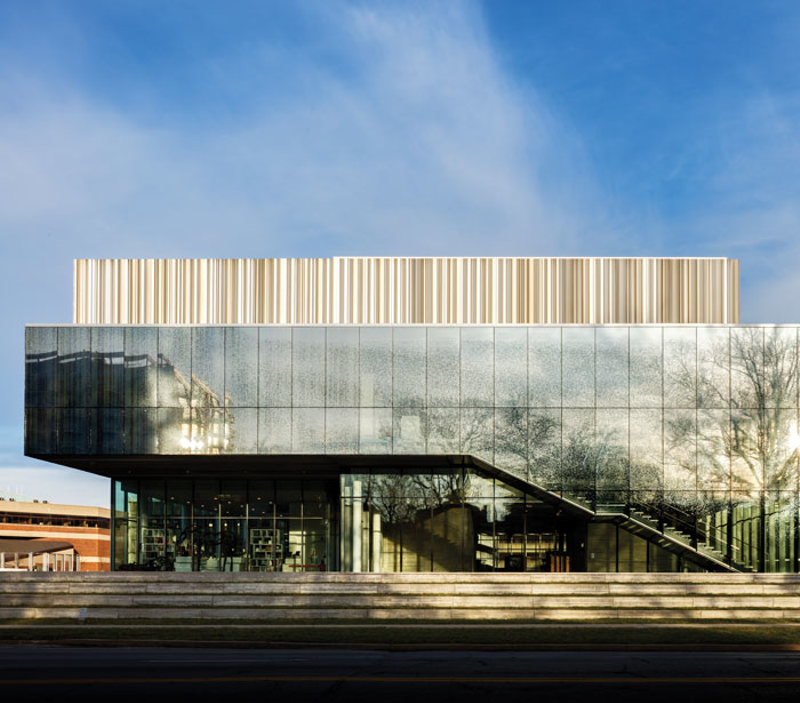Louisville took three years to construct its “new” art museum, but it’s safe to say that “speed” was always foremost on its mind. And now, with its decidedly contemporary Speed Art Museum, it has a most impressive addition to the city’s cultural offerings.
The new Speed consists of a large contemporary addition to the original Neo-Classical building that opened in 1927, which has also been renovated. The main addition is called the North Building; there is also a smaller new South Building.
J.B. Speed Memorial Museum, as it was originally called, highlighted the seriousness and lofty importance of an art museum’s mission — enlightening the public about important and enduring work, mostly of the past. That was a classic “city on a hill” vision of the art museum as ennobler, even if in this case the museum wasn’t physically on an isolated hill but rather adjacent to a college campus.Now that the institution reopened in March, a visit is instructive. It shows what the administrators of dynamic, growing public art museums seem to want. In a word, “contemporary.” They want a contemporary emphasis to their architecture, even while preserving or restoring their older buildings, and they want those new edifices to emphasize growing collections of Contemporary art (along with temporary exhibitions).
But the new buildings don’t have to be Frank Gehry’s Spanish Guggenheim Museum Bilbao. For the Speed Museum’s 62,500-square-foot North Building, the Los Angeles-based firm wHY created an eye-catching structure with lots of glass and many straight lines that calls attention to its surroundings as much as to itself.
Throughout the new Speed, there is a subtle, soothing pin-striping motif on sections of the complex’s interior and exterior surfaces and appointments.
Overall, the new Speed sees art — especially Contemporary — as a series of questions rather than pronouncements, and I think that makes the museum lively. At least, it certainly looked lively when I was there — it was jammed on a free-admission Sunday.
The North Building makes a thrilling first impression. The large central stairway seems to float through the atrium; the glass window panels are embedded with tiny silver metallic pieces to create an illusory rain effect (and control the sunlight’s intensity).
Among the artwork in this area is a life-size, translucent cast-glass gown that artist Karen LaMonte has titled “Odoriko.” You can see the sculpted folds. There’s a profound message in her work — fashion, costume and sculpture have more in common than we might initially think and are important equals in an art museum’s collection. (She also has a piece in the Cincinnati Art Museum’s collection.)
Once entering the North Building’s spacious galleries, there is much that’s appealing. It comes from the collection, loans and promised gifts. And not just by the recognizable big names of Contemporary art, though many — Roy Lichtenstein, Peter Voulkos, Sam Gilliam, Alice Neel, El Anatsui — are there. But there’s also work by less familiar artists who use non-traditional materials in innovative and thought-provoking ways.
I was particularly taken with a two-channel sound installation (is it still visual art?) on the upper-floor outdoor Art Terrace by Scottish artist Susan Philipsz. It’s a 2003 work called “Sunset Song” for which she has recorded herself singing two versions — from a female and male point-of-view — of the American murder ballad “Banks of the Ohio.” It’s chilling, even on a sunny day, especially when you’re standing not all that far from the banks of the Ohio River.
In the restored and renovated older building, work has more of an encyclopedic focus. It has a lower-level Kentucky Gallery, somewhat like our museum’s Cincinnati Wing, that benefits from featuring Kentucky’s great Folk art tradition. And in the roomy photography gallery, there is a strong section dedicated to the Lexington Camera Club, a mid-20th-century Kentucky movement that is gaining national recognition.
One still waits to see what the big traveling shows will be. But this is definitely a regional museum to visit now — for its architecture, its art and its spirit. Find more info at speedmuseum.org.
CONTACT STEVEN ROSEN: [email protected]


